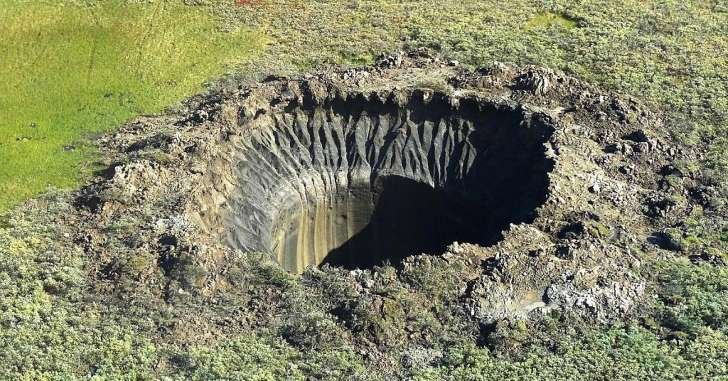
In northern Siberia, rising temperatures are causing mysterious giant craters — and even more dire consequences could be in store, say climate scientists.
The Russian province's long-frozen ground, called permafrost, is thawing, triggering massive changes to the region's landscape and ecology. It could even threaten human lives.
"The last time we saw a permafrost melting was 130,000 years ago. It's a natural phenomenon because of changes in the earth's orbit," said professor of earth sciences at the University of Oxford, Dr. Gideon Henderson.
But what is definitely unprecedented is the rate of warming. The warming that happened 130,000 years ago happened over thousands of years … What we see happening now is warming over decades or a century."
We are therefore seeing a much more rapid collapse of the permafrost, Henderson said.
Global warming — but faster
It's clear that the thawing permafrost has an important effect on the climate, Henderson said.
Under normal conditions, permafrosts regulate the amount of carbon in the environment by taking up and storing significant portions of carbon that humans release from burning fossil fuel.
n the case of Siberia, this equation is being reversed.
"When [permafrosts] release carbon, it will accelerate the rate of warming in the future," Henderson said. A self-reinforcing feedback loop is created whereby warming releases more carbon, which in turn produces greater warming.
Methane is 86 times worse than carbon dioxide
Since 2014, several massive sinkholes have been discovered in the region. The first one reportedly measured over 50 ft wide.
There are several hypotheses on how the craters are formed, but none of them has been proven, according to Dr. Vladimir Romanovsky, professor of geophysics at the University of Alaska Fairbanks.
"All these hypotheses, though, use the fact that temperature in the region is increasing," Romanovsky said.
The formation of these crater-like holes could have crucial ramifications for Siberia's community and the environment at large.
One theory suggests that the holes are created when trapped gases explode. Carbon dioxide and methane, both greenhouse gases, are released in the process.
According to conventional estimates, methane warms the planet by 34 times as much as carbon dioxide over 100 years. But such estimates ignore the fact that atmospheric methane decomposes into carbon dioxide, a less potent greenhouse gas, after 10 to 20 years.
Over a 20-year period, methane's warming potential is 86 times that of carbon dioxide, according to the Intergovernmental Panel on Climate Change.
It's still a question if the formation of these craters contributes significant amounts of greenhouse gases to the atmosphere, researchers say.
"There is no estimate for how much methane is released into the atmosphere because we don't know how" such craters are formed, Romanovsky said.
According to Henderson, scientists are also uncertain about the rate and types of gases ejected – specifically, whether methane decomposes into carbon dioxide before or after its release.
'The railway collapses, the roads fall apart'
The thaw is already adversely affecting the lives of northern Siberia's residents.
"People in permafrost regions rely on frozen ground for their infrastructure," Henderson said. "As the ground melts, the railway collapses, the roads fall apart, the buildings sink into the ground … It's happening already."
Threats to infrastructure will increase as melting continues, and can pose a problem to major industrial areas including oil and gas fields, he added.
And if it's true that gas explosions are creating the craters, such an event can kill people, said Romanovsky.
In Russia, the government and companies, especially gas extraction firms, are providing funds for further research into this phenomenon, according to Romanovsky.
Hi! I am a robot. I just upvoted you! I found similar content that readers might be interested in:
https://tetrasys.fi:10443/in/nyt/1096~151~1017335/Giant-craters-spell-trouble-for-Earth